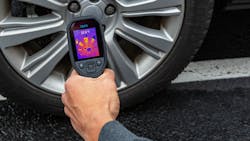Making the sale: Thermal imaging cameras
There are A LOT of tools and equipment technicians need to repair vehicles, but it can be hard to keep them all straight. Especially when you need to know not only what does, but how it compares to other tools just like it. Professional Distributor is here to help! In this article, we'll be looking at thermal imaging cameras and a few tips on how to make that sale.
1. Demonstrate the value
Shops want to buy equipment that provides demonstrated value. If they can see how a product will save them time and effort, they will be more likely to purchase it. This is especially important for thermal imaging tools since many shops believe that these tools are cost-prohibitive and out of budget.
“Thermal imagers are a high impact and hands-on tool,” Richard Wexler, director of instruments at FLIR adds. “Use a security cable if needed, but make sure customers can handle the imager and try it out. Seeing is really believing, and that’s what will get customers excited. The best way to demo it is to let them try it on a car they’re working on or to scan your truck’s components to see what it reveals.”
As a conversation starting point, ask the shop if they ever have a hard time convincing customers to agree to repairs. If they say yes, ask if the ability to show a customer a vivid picture of what’s wrong with their vehicle might help build trust and get them to agree to complex repairs that can be hard to explain.
2. Find the perfect fit
Ask questions about the specific applications that they will be using the thermal imaging tool for, and what features they would like to have. Then suggest a tool that best fits those needs. For example, if the shop intends to use the thermal imager for a lot of diesel engines or turbocharged engines, they will need a thermal imaging tool with a larger temperature range, so the tool can handle the temperatures these super-hot components can reach. More tech-savvy shops might appreciate a tool that has the ability to “talk” to the shop’s iPad using Bluetooth to show customers what the technician is working on.
3. Room for storage
Like with a phone or digital camera, image storage is an important consideration. Thermal imaging tools should have enough storage for larger, high-resolution images. As a general rule, 4GB is a good standard. Many thermal imagers have expandable memory, so consider stocking extra memory cards, as well as extra batteries and protective storage cases, to encourage add-on sales.
4. Understand what you're selling
Take the time to understand the tools you are trying to sell as thoroughly as possible, and take advantage of resources provided by the company, such as videos that help highlight the top features of each tool.
To learn more about thermal imaging cameras, click here.
